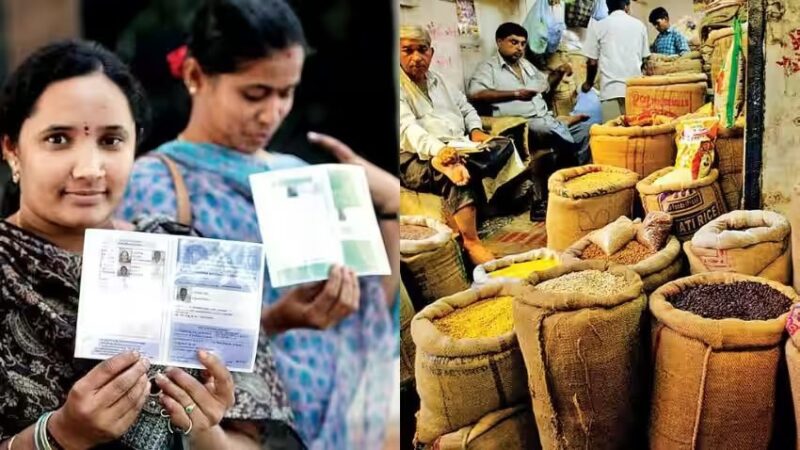
In 2025, India’s ration card system underwent significant upgrades aimed at offering better support and services to the citizens. These changes focus on improving transparency, reducing fraud, and expanding the benefits to include essential services beyond food security. The updated rules bring several advantages for all types of ration cardholders, including Priority Household (PHH), Antyodaya Anna Yojana (AAY), and general cardholders. Here’s a look at the top eight benefits for ration cardholders in 2025.
1. Free Monthly Ration
One of the most notable changes for ration cardholders in 2025 is the provision of free monthly rations. The government has extended the Pradhan Mantri Garib Kalyan Anna Yojana, allowing eligible households to receive free food grains, including rice, wheat, and pulses. The distribution of these rations has been made more transparent and efficient, thanks to the introduction of e-PoS (Electronic Point of Sale) machines. These machines ensure secure distribution with Aadhaar authentication, making the process seamless. Additionally, the portability feature allows ration collection from any fair price shop across India, which is particularly helpful for migrant workers.
2. Nationwide Portability
The One Nation One Ration Card (ONORC) scheme has been fully implemented, allowing beneficiaries to collect subsidized food grains from any state, regardless of where their ration card was originally issued. This nationwide portability is especially beneficial for migrant workers who move between states for work. Biometric verification ensures that only eligible beneficiaries can access the rations, preventing any potential misuse of the system. This scheme ensures food security across the country without regional limitations.
3. Health Insurance Coverage
Another major benefit introduced in 2025 is that eligible ration cardholders are now automatically enrolled in the Ayushman Bharat health insurance scheme. This scheme provides up to ₹5 lakh per year for hospitalization at empaneled hospitals. It covers major surgeries, maternity care, and chronic illness treatments. The best part is that no separate registration is required. The ration card itself serves as proof of eligibility, making it easier for low-income families to access quality healthcare.
4. LPG Connection Support
Under the Ujjwala Yojana, families holding ration cards now have priority for LPG subsidies. For households without an LPG connection, the government has simplified the application process using the ration card and Aadhaar. Once approved, they will receive a free LPG connection along with regular subsidies on refills. This initiative encourages the use of clean cooking fuel, reducing health risks associated with traditional cooking methods like using wood or coal, especially for rural women.
5. Education Assistance
The new guidelines also provide educational benefits for children of ration cardholders. These include access to various government-funded scholarships, including pre-matric, post-matric, and merit-based awards. The application process has been streamlined by linking it to the ration card database. This simplifies the process for deserving students, ensuring they don’t miss out on financial aid due to bureaucratic hurdles. The scholarships help cover tuition fees, books, and living expenses, making education more accessible to families in need.
6. Utility Bill Relief
To ease the financial burden on low-income families, many state governments are offering discounts on electricity bills for ration cardholders. Depending on the type of ration card, eligible households can receive discounts ranging from 25% to 50% on their electricity bills. Some states are also providing free electricity up to a certain limit. These discounts help reduce the financial strain on households and improve the affordability of essential services.
7. Priority in Welfare Schemes
Ration cardholders now have priority access to several government welfare schemes. This includes housing assistance under the Pradhan Mantri Awas Yojana (PMAY), pension schemes, and employment programs like MGNREGA (Mahatma Gandhi National Rural Employment Guarantee Act). The ration card serves as proof of economic status, making it easier to verify eligibility for these schemes. In addition, ration cardholders receive priority in disaster relief efforts, ensuring timely support during emergencies.
8. Online Services Access
To improve efficiency, the government has introduced online services for ration cardholders. They can now apply for new cards, update details, check their allotments, and lodge complaints through a digital portal. The integration of Aadhaar and mobile numbers ensures secure access and real-time updates, making it easier for citizens, especially those in rural areas, to manage their entitlements without visiting government offices.
The 2025 upgrades to India’s ration card system bring numerous advantages to cardholders. These reforms are aimed at enhancing food security, improving access to essential services, and offering critical support to low-income families. With the introduction of digital tools, better transparency, and extended benefits like free rations, health insurance, and utility bill relief, the new system is a significant step toward empowering citizens. These changes ensure that benefits are delivered fairly and efficiently, providing a robust social safety net for vulnerable populations.